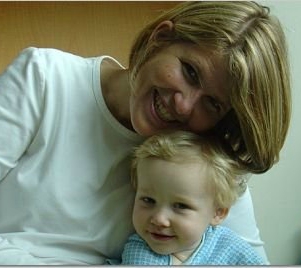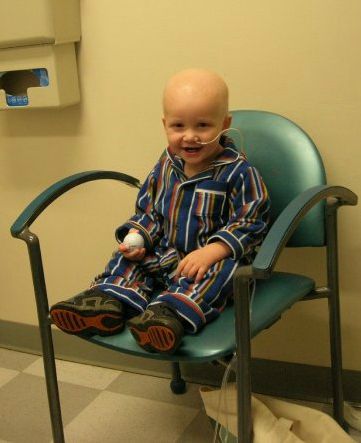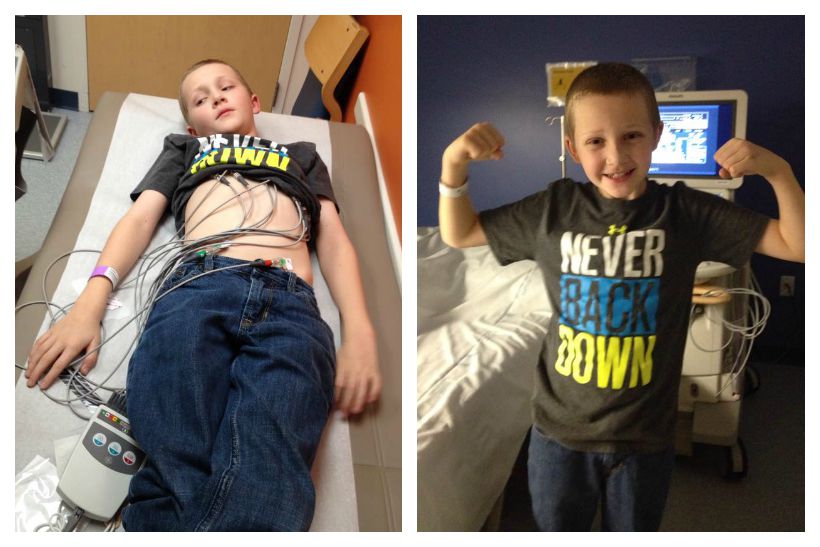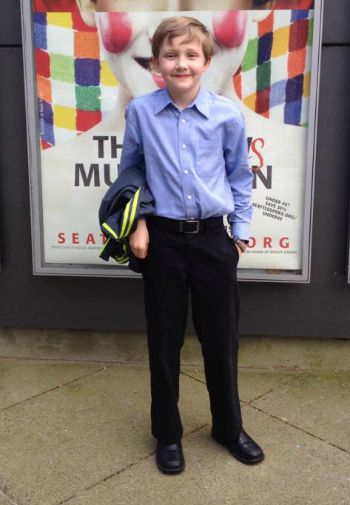Kelly, St. Baldrick’s Hero Fund Manager and mom to Honored Kid Jackson, shares her take on a recent childhood cancer survivorship study.

Kelly cuddles Jackson in the hospital shortly after he was diagnosed with childhood cancer.
The months that followed were incredibly hard. We had to learn to navigate through an enormous hospital that had become our new home. We had a crash course in medical terminology and the names of all the drugs. We quickly learned tricks to administer IV medications to an uncooperative toddler, all while doing our best to keep him as comfortable and happy as possible.
I quickly developed some coping skills. One of them was gathering information. I wanted to know everything about Jackson’s cancer and the side effects of his treatment.
With time, that quest for information shifted to include childhood cancer research.

Jackson, 18 months old, playing in the hospital.
In early June, I read one of those studies that made me want to dance. St. Jude released a long-term survivorship study that shared some very good news!
In recent decades, researchers have made significant strides treating some of the most common childhood cancers, specifically acute lymphoblastic leukemia (ALL), Wilms tumor and lymphoma. Five-year prognosis rates for these specific cancers surpass 85%. This progress has afforded researchers the opportunity to focus on not just curing the child of the disease, but also minimizing the potential side effects caused by treatment. Trials have been done to see if children will survive their cancer battle without radiation or without whopping doses of cardio-toxic chemotherapy.
This recent survivorship study clearly showed this effort to reduce toxicity is paying off. The researchers found that more children are surviving those cancers, and with fewer long-term health consequences.
BLOG: 5 Facts About Childhood Cancer Survivors >
This story was picked up by the mainstream news media, and titles like “Gentler cancer treatments help kids survive, thrive” flew across my Facebook feed. That one in particular stuck out to me.
“Thrive” is a well-used word in our household as we navigate the long-term side effects caused by Jackson’s treatment a decade ago. Over the past 10 years, oncologist appointments have been replaced with visits to the cardiologist, nephrologist, neuropsychologist, gastroenterologist, dentist and the survivorship clinic. Our collective focus has shifted from fighting for Jackson to survive, to helping him thrive.

Jackson getting an EKG at a recent cardiologist appointment.
So while I was thrilled to see childhood cancer research in the news, my mind quickly went to what didn’t get covered in the story.
What about the cancers that don’t have a good five-year prognosis? What does survivorship look like for neuroblastoma, sarcoma, brain tumor patients … and what about Jackson and his rhabdoid tumor of the kidney?
At the heart of the issue are the larger cancer organizations that lump all types of childhood cancer together. ALL, with its five-year prognosis of 90%, is lumped in the same group with DIPG, which has a five-year prognosis of 0%. The term “childhood cancer” actually encompasses 12 different subgroups made up of hundreds of different types of cancers. Many of these cancers have nothing to do with one another and their treatments are very different, yet they fit into the “childhood cancer” box.
Unfortunately, this “lump them all together” approach gives a distorted picture.It’s common to hear some of these organizations happily point to the statistic that over 80% of children survive their cancer battle. Much of this is because of the amazing success that’s been made in treating ALL, the most common form of childhood cancer. Back in the 1960s only 10% of children diagnosed with ALL survived. Today that number exceeds 90 percent. We’ve seen similar advances in treating non-Hodgkin lymphoma and Wilms tumor.
The progress that’s been made with these common childhood cancers is wonderful, and it deserves to be celebrated. But we can’t let it overshadow the reality that researchers are still struggling to find effective treatments for neuroblastoma, sarcomas and many brain tumors.
For many of these cancers, scaling back therapies to reduce late effects isn’t even an option when there’s no known effective treatment protocol.
BLOG: Late Effects of Grace’s Childhood Cancer Treatment >

“While Jackson looks and acts like a ‘normal’ child, he isn’t normal on the inside,” Kelly says.
Until we can say that for all types of cancers, the fight to conquer childhood cancers isn’t over!
I want to thank every person who has fought alongside our family and St. Baldrick’s the past 10 years. We are making progress! I firmly believe that the good news needs to be celebrated, and for me that involves a little dance.
But, I don’t want those headlines to distract us from the fact there is still a lot of work to be done. We need to keep fighting for cures for all children, and for better cures for the growing number of childhood cancer survivors.
Your efforts to raise those dollars will ensure we can continue to make strides in treating all types of childhood cancers, and in giving all childhood cancer survivors the opportunity to thrive for decades.
It’s Childhood Cancer Awareness Month. Get involved and help all kids with cancer not just survive, but thrive.
Read more about childhood cancer survivors:


 SBF
Tweets »
SBF
Tweets »